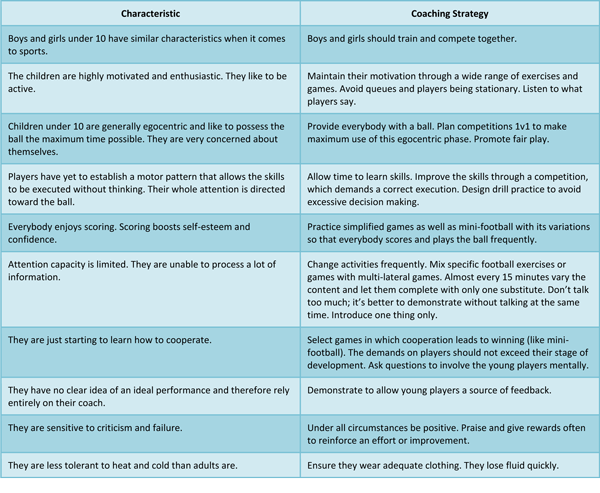Reproduced from “Developing Youth Football Players” by Horst Wein.
The key to developing successful youth football players is in understanding and meeting the needs of young players rather than subjecting them to boring exercises or a game designed for adults. These are some basic, yet important, needs children have that coaches should always keep in mind.
Need for security
During training, children need a familiar and intimate atmosphere that gives them security and confidence. Frequent changes of training site or coach or educator is not recommended. Returning to games that they are already familiar with (but with some variations) is welcomed by kids as long as the contents of the training sessions link with something that they already know. Children require stability.
Training should always take place in a safe environment, and specific rules should be applied to ensure safety and avoid any dangerous situations.
Need for new experiences
Nothing can be understood completely when it has not been experienced first. Coaches should allow children to experiment with tasks. Children need to discover on their own everything that surrounds them. This also applies to the world of sport and in particular to football. Kids should be stimulated with games and activities that are within their physical and mental capacities. This method of coaching allows them to develop their abilities and capacities step by step through their own discovery.
Need to be acknowledged
Children become highly motivated when their efforts in mastering a skill or problem are praised. Through praise they are encouraged to try even harder. To children younger than 12 years old, the teacher, coach or parent is like a mirror in which they see their capacity or incapacity. That is why educators and parents have to learn to be positive, to praise the children frequently and keep critical comments to a minimum.
Need to show responsibility
Children prefer to do things on their own without depending too much on adults. They like to reach independence as quickly as possible. The coaching methods and behaviour of the educator should consider this need, making sure that the children are frequently allowed to find solutions on their own to problems the coach presents. The educator should interfere only when the problems cannot be solved by the pupils. Youngsters can also perform the task of putting down or collecting cones, modifying the rules of a practice game, or choosing players for demonstrations or certain activities. Their need to demonstrate responsibility can also be stimulated in each training session by allowing them 10 minutes to freely choose what to practice, how to do it, and where and with whom to execute a determined skill or game.
Coaches who are reluctant to give up some responsibility to the children must realise that learning also takes place out of their presence. In any team game the world over, children organise their play in its logical fashion even if an adult is not available to guide them. First, they make sure that the teams are even because they want competition. They want the game to be fair and challenging, thus forcing them to play to their full potential. Second, kids don’t need referees. The players take care of the rules themselves, modifying them according to conditions and the environment: no off-side, more players, bigger field and so forth. Third, teams are often composed of players of various ages. The younger players learn from the older ones, who, at the same time, are challenged by the younger players. This is how good teams are built at the senior level as well.
Need to play
Playing games is as vital for children as sleep. Playing is necessary for the health of their body and minds. As children learn by playing, the central part of each training session should be the practice and understanding of simplified games. The art of coaching is to always adapt instruction to the children’s ability and capacity level – not vice versa. Playing games stimulates communication and decision-making; playing football without thinking can be compared to shooting without aiming.
Need to socialise
Children instinctively look for communication with others. The older they are, the more they need company of a similar age. They love to be associated and to identify themselves with a group or team with the aim of achieving common objectives.
Need to move
Nature wants children to be active. Youngsters have no patience to wait in queues for their turn. The rules of adult games must be modified to allow children to play the ball more often. Games with fewer players assure active participation.
Need to live in the present
Generally, neither the past nor the future interests children very much. Their sense of time is completely different from that of adults. Children live intensely in the present, without bothering about tomorrow or yesterday, which they deem to be far away.
Need for variety
Children crave variety, which results in less boredom and fatigue. A great variety of stimulation is fundamental to maintaining their attention level. Unless coaches frequently vary the method of presentation and its contents, most children’s attention deviates. Coaches should also vary the grade of intensity of the exercises and games.
Need to be understood by adults
Children seem to live in a different world: They have different problems, they learn differently and they don’t think as logically as adults do. Their ideas, thoughts and reasoning often lack coherence. Their emotional constancy depends to a high degree on their speed of biological growth. In general kids don’t know how to use their energy well and, therefore, tire easily. They behave exactly the way they feel. For all these reasons, adults who live and work with children should know how to stimulate and guide them in their search for personality and identity.

